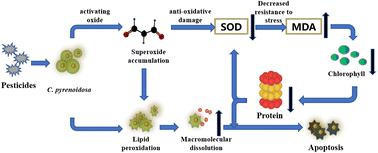当前位置:
X-MOL 学术
›
Environ. Sci.: Processes Impacts
›
论文详情
Our official English website, www.x-mol.net, welcomes your feedback! (Note: you will need to create a separate account there.)
Combined toxicity and adverse outcome pathways of common pesticides on Chlorella pyrenoidosa
Environmental Science: Processes & Impacts ( IF 5.5 ) Pub Date : 2024-02-08 , DOI: 10.1039/d3em00525a Jing Zhang 1 , Jin Zhang 1 , Xianhuai Huang 1 , Fazhi Xie 1 , Biya Dai 1 , Tianyi Ma 1 , Jianping Zeng 1
Environmental Science: Processes & Impacts ( IF 5.5 ) Pub Date : 2024-02-08 , DOI: 10.1039/d3em00525a Jing Zhang 1 , Jin Zhang 1 , Xianhuai Huang 1 , Fazhi Xie 1 , Biya Dai 1 , Tianyi Ma 1 , Jianping Zeng 1
Affiliation

|
Pesticides due to their extensive use have entered the soil and water environment through various pathways, causing great harm to the environment. Herbicides and insecticides are common pesticides with long-term biological toxicity and bioaccumulation, which can harm the human body. The concept of the adverse outcome pathway (AOP) involves systematically analyzing the response levels of chemical mixtures to health-related indicators at the molecular and cellular levels. The AOP correlates the structures of chemical pollutants, toxic molecular initiation events and adverse outcomes of biological toxicity, providing a new model for toxicity testing, prediction, and evaluation of pollutants. Therefore, typical pesticides including diquat (DIQ), cyanazine (CYA), dipterex (DIP), propoxur (PRO), and oxamyl (OXA) were selected as research objects to explore the combined toxicity of typical pesticides on Chlorella pyrenoidosa (C. pyrenoidosa) and their adverse outcome pathways (AOPs). The mixture systems of pesticides were designed by the direct equipartition ray (EquRay) method and uniform design ray (UD-Ray) method. The toxic effects of single pesticides and their mixtures were systematically investigated by the time-dependent microplate toxicity analysis (t-MTA) method. The interactions of their mixtures were analyzed by the concentration addition model (CA) and the deviation from the CA model (dCA). The toxicity data showed a good concentration–effect relationship; the toxicities of five pesticides were different and the order was CYA > DIQ > OXA > PRO > DIP. Binary, ternary and quaternary mixture systems exhibited antagonism, while quinary mixture systems exhibited an additive effect. The AOP of pesticides showed that an excessive accumulation of peroxide in green algae cells led to a decline in stress resistance, inhibition of the synthesis of chlorophyll and protein in algal cells, destruction of the cellular structure, and eventually led to algal cell death.
中文翻译:

常见农药对蛋白核小球藻的综合毒性和不良后果途径
农药由于大量使用,通过多种途径进入土壤和水环境,对环境造成极大危害。除草剂和杀虫剂是常见农药,具有长期生物毒性和生物蓄积性,会对人体造成危害。不良结果途径(AOP)的概念涉及在分子和细胞水平上系统地分析化学混合物对健康相关指标的反应水平。 AOP将化学污染物的结构、有毒分子引发事件和生物毒性的不良结果关联起来,为污染物的毒性测试、预测和评估提供了新的模型。因此,选取敌草快(DIQ)、氰嗪(CYA)、敌百虫(DIP)、残杀威(PRO)、草酰(OXA)等典型农药作为研究对象,探讨典型农药对蛋白核小球藻(C.pyrenoidosa )的联合毒性。 )及其不良后果途径(AOP)。采用直接均分射线(EquRay)法和均匀设计射线(UD-Ray)法设计农药混配体系。采用时间依赖性微孔板毒性分析(t-MTA)方法系统研究了单一农药及其混合物的毒性作用。通过浓度加成模型(CA)和CA模型偏差(dCA)分析它们混合物的相互作用。毒性数据显示出良好的浓度-效应关系; 5种农药的毒性不同,顺序为CYA>DIQ>OXA>PRO>DIP。二元、三元和四元混合物体系表现出拮抗作用,而五元混合物体系则表现出相加作用。农药的AOP表明,绿藻细胞内过量的过氧化物积累导致抗逆性下降,抑制藻细胞叶绿素和蛋白质的合成,破坏细胞结构,最终导致藻细胞死亡。
更新日期:2024-02-08
中文翻译:

常见农药对蛋白核小球藻的综合毒性和不良后果途径
农药由于大量使用,通过多种途径进入土壤和水环境,对环境造成极大危害。除草剂和杀虫剂是常见农药,具有长期生物毒性和生物蓄积性,会对人体造成危害。不良结果途径(AOP)的概念涉及在分子和细胞水平上系统地分析化学混合物对健康相关指标的反应水平。 AOP将化学污染物的结构、有毒分子引发事件和生物毒性的不良结果关联起来,为污染物的毒性测试、预测和评估提供了新的模型。因此,选取敌草快(DIQ)、氰嗪(CYA)、敌百虫(DIP)、残杀威(PRO)、草酰(OXA)等典型农药作为研究对象,探讨典型农药对蛋白核小球藻(C.pyrenoidosa )的联合毒性。 )及其不良后果途径(AOP)。采用直接均分射线(EquRay)法和均匀设计射线(UD-Ray)法设计农药混配体系。采用时间依赖性微孔板毒性分析(t-MTA)方法系统研究了单一农药及其混合物的毒性作用。通过浓度加成模型(CA)和CA模型偏差(dCA)分析它们混合物的相互作用。毒性数据显示出良好的浓度-效应关系; 5种农药的毒性不同,顺序为CYA>DIQ>OXA>PRO>DIP。二元、三元和四元混合物体系表现出拮抗作用,而五元混合物体系则表现出相加作用。农药的AOP表明,绿藻细胞内过量的过氧化物积累导致抗逆性下降,抑制藻细胞叶绿素和蛋白质的合成,破坏细胞结构,最终导致藻细胞死亡。



























 京公网安备 11010802027423号
京公网安备 11010802027423号